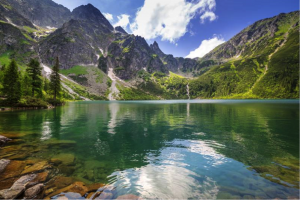Krakow is very touristic and one of the oldest cities in Poland, with lots of historical places and monuments. There is also a lot of nature outside of the city, and many nature trips are possible.
Kraków Public Transport
Kraków tram and bus lines make moving around the city (and the neighbouring Wieliczka) fairly easy.
You can find the timetables on the website of the Municipal Transport Enterprise (browser in Englishhttp://www.mpk.krakow.pl/en/) and at the bus stops.
All tickets must be punched in a ticket machine immediately on boarding a bus or a tram. The validity of timed and daily tickets is specified by the four last digits stamped on your tickets, which show the exact time when you first punched the ticket.
The tickets can be purchased in:
local kiosks,
ticket machines at bus stops (in the city centre they can be found at almost all the bus stops; the machines take both banknotes and most coins),
ticket selling booths by Teatr Bagatela (Bagatela Theatre at ul. Podwale) and by the Main Railway Station at ul. Basztowa,
in the seasonal tickets sales office (in the city centre – ul. Podwale 3/5),
on buses and trams in ticket machines (available in the new tram or bus models; they take coins only) or with a driver (you must be sure to hand in the correct change and additional charge is added onto the regular price of the ticket),
You can also sightsee the city by bike. There are a lot of companies offering such service, for example
Currency exchange bureaus
Money can be exchanged at exchange bureaus and banks. Banks usually charge a commission, and the exchange is less profitable.
When exchanging money in an exchange bureau, pay attention to the exchange rates.
IMPORTANT:
Before you conclude a transaction:
Compare the exchange rate displayed outside the exchange bureau with the one offered inside!
Safety
Krakow is a safe city, but it is also one of the largest cities in Europe. You need to remember about basic safety rules, especially during the tourist season when a lot of people visit the city. In case of a threat, contact the emergency number listed below.
Emergency phones
Emergency number to dial from mobile telephones: 112
Medical emergency service: 999
Police: 997, 112 (from mobile telephones)
Fire brigade: 998
City guards: 986
– Main Market Square
– Walk through the old town streets and sightseeing of interesting buildings around
– Jagiellonian University (one of the oldest in Europe)
– Mariacki Church and the biggest wooden Medieval Altar by Veit Stoss
– Wawel Castle and Wawel Cathedral (visiting Royal Tombs and Sigismund Bell)
– Walk through old Jewish district
Wawel Hill
Wawel Hill in Krakow, the mecca for foreign tourists, is a microcosm of Polish history and culture. From the 11th century on Poland’s monarchs took up their residence here in the Royal Castle. And they were both crowned and buried here, in the Wawel Cathedral where later on Polish national heroes have also been laid to rest since the 19th century. The place not only overflows with priceless art treasures, architectural beauties, relics of the past and curiosities. It is also full of glory, magic, history and fable.
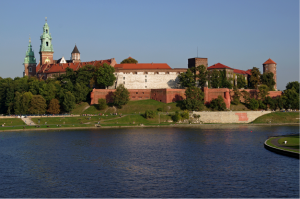
Wawel Royal Castle
Home to three dynasties of Poland’s monarchs. Its stately halls and exquisite chambers are filled with priceless art, best period furniture and rare ancient objects. The collection of the 16th-century monumental Flemish tapestries is matchless.
Wawel Cathedral houses Poland’s impressive national shrines and church art. Among its 18 chapels are true architectural masterpieces. The giant bell Zygmunt of 1520 ranks with the world’s largest. Most Polish kings and their family members are buried in the cathedral, its chapels and crypts, together with the greatest national heroes, two poets, four saints and numerous bishops.
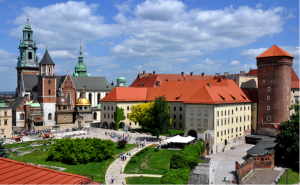
Dragon’s Den
Huge natural cavity inside the Wawel Hill is the legendary home of a legendary monster.
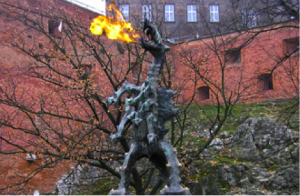
Cracow’s history museum
It is an interactive exhibition that was made possible thanks to the archaeological study that was conducted continuously from 2005 to 2010, on the Main Market Square. Discovered at the time were an abundance of traces of the many centuries of history of the site. To accommodate them, an archaeological reserve unique in Europe, covering nearly 4000 sq.m (43,000 sq.ft), was fashioned under the surface of the Main Market Square to provide a display for the treasures that had been found and narrate the turbulent history of Medieval Kraków.
The Rynek Underground exhibition presents real historical objects on display, just to mention 14th-century coins, decorations, and pottery, as proof of the European cultural and trade exchange that continued here incessantly for hundreds of years.
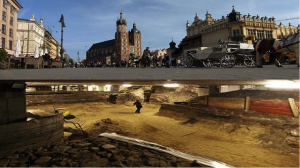
Old Market Square with Virgin Mary’s church and altar
Krakow’s central Grand Square (Rynek Glowny, often translated wrongly as “Main Market”) has been the hub of the city ever since its Old Town historical district got the present grid of streets in the 13th century. The huge 10-acre square, the largest of all Europe’s medieval cities, is a curio in itself. At the same time, it is arguably one of the world’s most beautiful plazas.
Historical monuments at the Rynek Glowny grand square.
Krakow’s chief landmarks at the Rynek Glowny central square are the 16th-century Renaissance Cloth Hall in the center, the 13th-century Gothic Town Hall Tower, the magnificent 14th-century Gothic basilica of the Virgin Mary’s with its astonishing Great Altar and the tiny church of St. Adalbert’s whose parts date back to the 11th century. Yet practically all the Grand Square’s 47 buildings boast a considerable historical and/or architectural value. And one cannot but regret that some edifices once standing amid it were pulled down during the 19th century, notably the 14th-century Gothic Town Hall.
Main Old Market Square is the center of the city. It is the largest of medieval European markets, is arguably one of the world’s most beautiful plazas. It boasts a plethora of landmarks and myriad restaurants, clubs, and cafes. Grate place for a night out especially because of abundance of pubs and bars right next to each other, in the basements of historical buildings.
St Mary’s church on the Main Square has many things to recommend it: its painstakingly restored interior is almost overwhelming in its opulence. But surely the highlight must be the 13 meter (42 foot) high 15th century altarpiece by Veit Stoss (Polish: Wit Stwosz), the largest Gothic sculpture in the world. Arranged as a triptych, it shows various scenes from the life of the Virgin Mary, with the centrepiece depicting the death of the Madonna surrounded by the twelve apostles. Carved from wood and lavishly gilded the figures are exceptionally realistic. A good time is to visit around noon, when light floods through the magnificent stained glass windows and is reflected back by the glittering gold of the altarpiece. What is important to notice, while strolling near the church is that every full hour a golden trumpet shows above Krakow’s central Grand Square in the west window just below the spire of the higher, municipal tower of the Basilica of the Virgin Mary’s. A player plays a special song to the four sides of the world. One of the towers is opened for visitors (Tue, Thurs, Sat, 9:00–11:30 and 13:00–17:30) and has a beautiful view for the whole Old City.
Grand Square of Historical Krakow

Jagiellonian University – Collegium Maius
The Grand College, or Collegium Maius, the oldest college of Poland’s oldest and best university, houses the University Museum now. It is one of the oldest universities in the world. It was rebuilt by the end of the 15th century as a splendid late-Gothic edifice around a vast courtyard with surrounding arcades and a well of 1517 in the center. Professors lived and worked upstairs, while lecturing downstairs. In the 1490s they had Copernicus among their students. Inside you can find a lot of artifacts, like tools that Copernicus used to study astronomy.
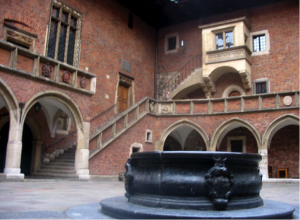
Jewish Kazimierz
Originally Krakow’s Jewish Quarter, Kazimierz was for centuries where Catholics and Jews existed peacefully side-by-side, having a noticeably different architectural character than the main city. Following the disappearance of virtually all the Jewish population in the Second World War and its aftermath, Kazimierz fell into something of a decline, and it wasn’t until the mid 1990s that the area started to be revitalized. Less overtly touristic than the Old Town, Kazimierz is considered by many residents to be the prime area for nightlife.
Kazimierz has two main focal points: ul. Szeroka, a long and wide cobbled street featuring the Old Synagogue at one end and numerous restaurants along it; and Plac Nowy, a small square with a flea market and numerous bars and cafes and a bustling nightlife. Amazing place for young people to chill out, drink a beer and grab a snack.

Schindler’s Factory
Exhibition Kraków under Nazi Occupation 1939–1945 is located in the former administrative building of Oskar Schindler’s Enamel Factory at 4 Lipowa Street.
The exhibition is primarily a story about Kraków and its inhabitants, both Polish and Jewish, during World War Two. It is also a story about Nazi Germans – the occupiers who arrived here on 6 September 1939, brutally disrupting Kraków’s centuries-long history of Polish-Jewish relations. The great history of World War Two intersects here with everyday life, and the personal dramas of individual people overlap with the tragedy which affected the whole world.
The wartime history of Deutsche Emailwarenfabrik – DEF – and its owner Oskar Schindler was brought into the limelight in 1993 by Steven Spielberg’s film Schindler’s List. Ever since that time, tourists from all over the world have been coming to Lipowa Street to visit the place where Schindler saved the lives of over a thousand people. The character of Oskar Schindler and the life stories of the Kraków Jews he saved are presented in the exhibition as part of the city’s complex wartime history. Oskar Schindler’s heroic attitude is presented in close-up in his former office – luckily, the historic room located in the factory’s administrative building has been preserved intact throughout the years. The dominant feature here is the symbolic “Survivors’ Ark” made of thousands of enamelled pots, similar to those manufactured by Schindler’s employees during the war.
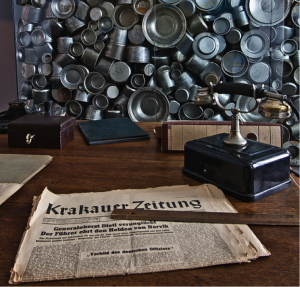
Nowa Huta
Nowa Huta, or New Steelworks, is Krakow’s newest borough and Stalin’s gift to the people of Krakow. Although the area had been populated since Neolithic times, and there are some beautiful monasteries and churches remaining in the outlying villages, it is the Socialist Realist new town that now grabs the lion’s share of tourist attention. Started in 1949, the plan was to create a massive steel mill and alongside a town to accommodate the workers, whose design would adhere to the Socialist Realist architectural principles very much in vogue in the Soviet Bloc. In addition, details appropriated from Renaissance architecture were to be included, as it was felt this better reflected Poland’s own architectural tradition. In fact the final result would be a mixture of Renaissance, Baroque and Classic styles, with later buildings coming more to embrace Modernism. For many, Nowa Huta can be seen as a place that encapsulates Poland’s time under communist rule, and to this extent it is a living museum to that era.
Nowa Huta is a short tram ride from Krakow city centre, and a natural alighting point is Plac Centralny, renamed Plac Ronald Reagan to somewhat mixed feelings in 2004. From this large grassy square, five main thoroughfares spread out in a fan shape. To the east lie the vast steelworks, now owned by Mittal Steel and employing but a fraction (albeit more efficiently) of the huge workforce that made Nowa Huta Poland’s biggest steel mill.
A large part of the population was imported wholesale from former Polish territories in what is now modern Ukraine and, post-communism, there was high unemployment with its contingent problems. Nevertheless recent years have seen something of a revival, whether it be the town’s increasing attraction to artistic and cultural types, the popularity of the various ‘communism’ tours or the various theatrical and musical events – in particular the annual ‘Sacrum Profanum’ festival, which draws ever greater numbers with each passing year, thanks to its bold programming of both early and baroque music as well as cutting edge contemporary and electronic music.
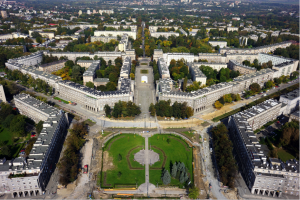
Wieliczka
Wieliczka salt mine is undeniably an awesome example of human endeavour. Its justification for inclusion on UNESCO’s World Heritage list includes the fact that it is the only mining site in the world to have been running continuously since the Middle Ages. The massive salt deposits were formed about twenty million years ago with the evaporation of the sea and subsequent upwards forcing by the nearby Carpathian mountains. Nowadays there are estimated to be about 300 kilometers of underground tunnels, reaching a maximum depth of 327 meters (nearly 1,100 feet). The salt mine tour includes many wonders: in addition to the mine itself are vast “crystal caverns” whose walls glisten with natural halite crystal formations. The there are the man made marvels, not least of which is St Kinga’s chapel, surely the most opulent underground church in the world, with its sculptures, reliefs and even chandeliers all carved from the natural rock salt. Wieliczka is about 20 minutes by bus from the centre of Krakow and the guided tour lasts about 3 hours.
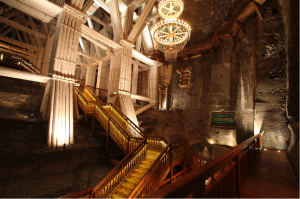
Auschwitz
Just over 50 kilometers west of Krakow lies the small town of Oswiecim, a place that would easily have remained in relative obscurity were it not for the Nazis’ decision to construct the Auschwitz-Birkenau concentration (and later death) camp there. Since the war ended, the site has been preserved as a museum and memorial, and receives over a million visitors a year. Allow a good three hours for the visit, which includes both camps: Auschwitz I and Auschwitz II-Birkenau. Although it is generally most notorious for the huge numbers of Jews murdered there, it is worth pointing out that a considerable quantity of non-jewish Poles also died there. Visiting the camp is part of the Polish schools’ curriculum. Be advised that for many visitors it can be a profoundly moving experience. Admission to the museum is free but various types of guided tour are available at differing prices

The mountains
Krakow is on the south of Poland just before the Tatra mountain range starts. If you want to do some hikes and see beautiful nature – it is a best place to be with mountain peakes higher than 2000m. It is also a perfect place for a one day trip without trecking shoes – just to enjoy the views and not get to tired. Tatra range is located in the Tatra National Park.
To get to the muntains is simple. You have to reach the biggest city in the mountains – Zakopane – u can take a bus or train form Krakow (2h ride).
Even if you are not prepared for high mountain ranges choose an easy track to the Morskie Oko lake. Path is even paved at parts and is not steap at all. After 2,5h takes you to the one of the most beautiful lakes in Europe (1395m asl). It is easy to get there form centrum of Zakopane – just take one of small busses there (10zl ticket) and in 25 min you can start hiking to the lake. They are used to forigners so it is relatively easy.
Here an useful web page about many tracks in the mountains and how and where to get.
